Strategic Health Leadership & Management: Transformational Change
VerifiedAdded on 2023/04/08
|9
|1926
|313
Essay
AI Summary
This essay provides an analysis of the article "Implementing and sustaining transformational change in health care: lessons learnt about clinical process redesign" by McGrath et al. (2008). The essay examines the central arguments and conclusions of the article, focusing on the five primary elements for achieving transformational change: leadership excellence, teamwork, stakeholder engagement, client intimacy, and resource management. It critiques the article's reliance on NSW Health data and identifies missing information, such as the importance of a well-communicated vision, change management models, the role of change agents, and comprehensive training and development. The essay concludes by discussing the implications of the article's findings for health leadership and management, emphasizing the adoption of process redesign, the coordination of change processes, stakeholder involvement, and the importance of performance management during process redesign. Desklib offers a platform for students to access similar solved assignments and study resources.

Running head: STRATEGIC HEALTH LEADERSHIP AND MANAGEMENT 1
Strategic Health Leadership and Management
Student’s Name
University Affiliation
Strategic Health Leadership and Management
Student’s Name
University Affiliation
Paraphrase This Document
Need a fresh take? Get an instant paraphrase of this document with our AI Paraphraser
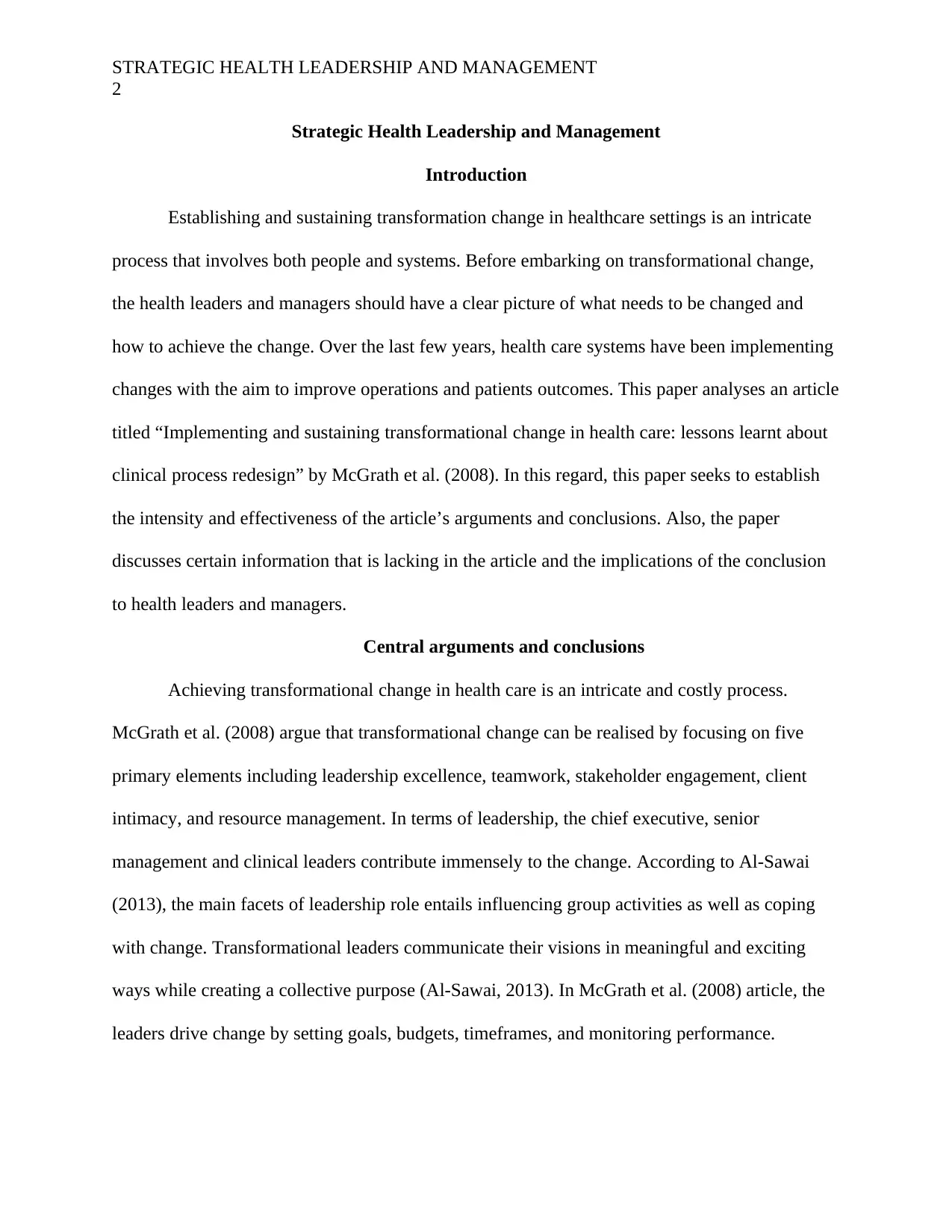
STRATEGIC HEALTH LEADERSHIP AND MANAGEMENT
2
Strategic Health Leadership and Management
Introduction
Establishing and sustaining transformation change in healthcare settings is an intricate
process that involves both people and systems. Before embarking on transformational change,
the health leaders and managers should have a clear picture of what needs to be changed and
how to achieve the change. Over the last few years, health care systems have been implementing
changes with the aim to improve operations and patients outcomes. This paper analyses an article
titled “Implementing and sustaining transformational change in health care: lessons learnt about
clinical process redesign” by McGrath et al. (2008). In this regard, this paper seeks to establish
the intensity and effectiveness of the article’s arguments and conclusions. Also, the paper
discusses certain information that is lacking in the article and the implications of the conclusion
to health leaders and managers.
Central arguments and conclusions
Achieving transformational change in health care is an intricate and costly process.
McGrath et al. (2008) argue that transformational change can be realised by focusing on five
primary elements including leadership excellence, teamwork, stakeholder engagement, client
intimacy, and resource management. In terms of leadership, the chief executive, senior
management and clinical leaders contribute immensely to the change. According to Al-Sawai
(2013), the main facets of leadership role entails influencing group activities as well as coping
with change. Transformational leaders communicate their visions in meaningful and exciting
ways while creating a collective purpose (Al-Sawai, 2013). In McGrath et al. (2008) article, the
leaders drive change by setting goals, budgets, timeframes, and monitoring performance.
2
Strategic Health Leadership and Management
Introduction
Establishing and sustaining transformation change in healthcare settings is an intricate
process that involves both people and systems. Before embarking on transformational change,
the health leaders and managers should have a clear picture of what needs to be changed and
how to achieve the change. Over the last few years, health care systems have been implementing
changes with the aim to improve operations and patients outcomes. This paper analyses an article
titled “Implementing and sustaining transformational change in health care: lessons learnt about
clinical process redesign” by McGrath et al. (2008). In this regard, this paper seeks to establish
the intensity and effectiveness of the article’s arguments and conclusions. Also, the paper
discusses certain information that is lacking in the article and the implications of the conclusion
to health leaders and managers.
Central arguments and conclusions
Achieving transformational change in health care is an intricate and costly process.
McGrath et al. (2008) argue that transformational change can be realised by focusing on five
primary elements including leadership excellence, teamwork, stakeholder engagement, client
intimacy, and resource management. In terms of leadership, the chief executive, senior
management and clinical leaders contribute immensely to the change. According to Al-Sawai
(2013), the main facets of leadership role entails influencing group activities as well as coping
with change. Transformational leaders communicate their visions in meaningful and exciting
ways while creating a collective purpose (Al-Sawai, 2013). In McGrath et al. (2008) article, the
leaders drive change by setting goals, budgets, timeframes, and monitoring performance.
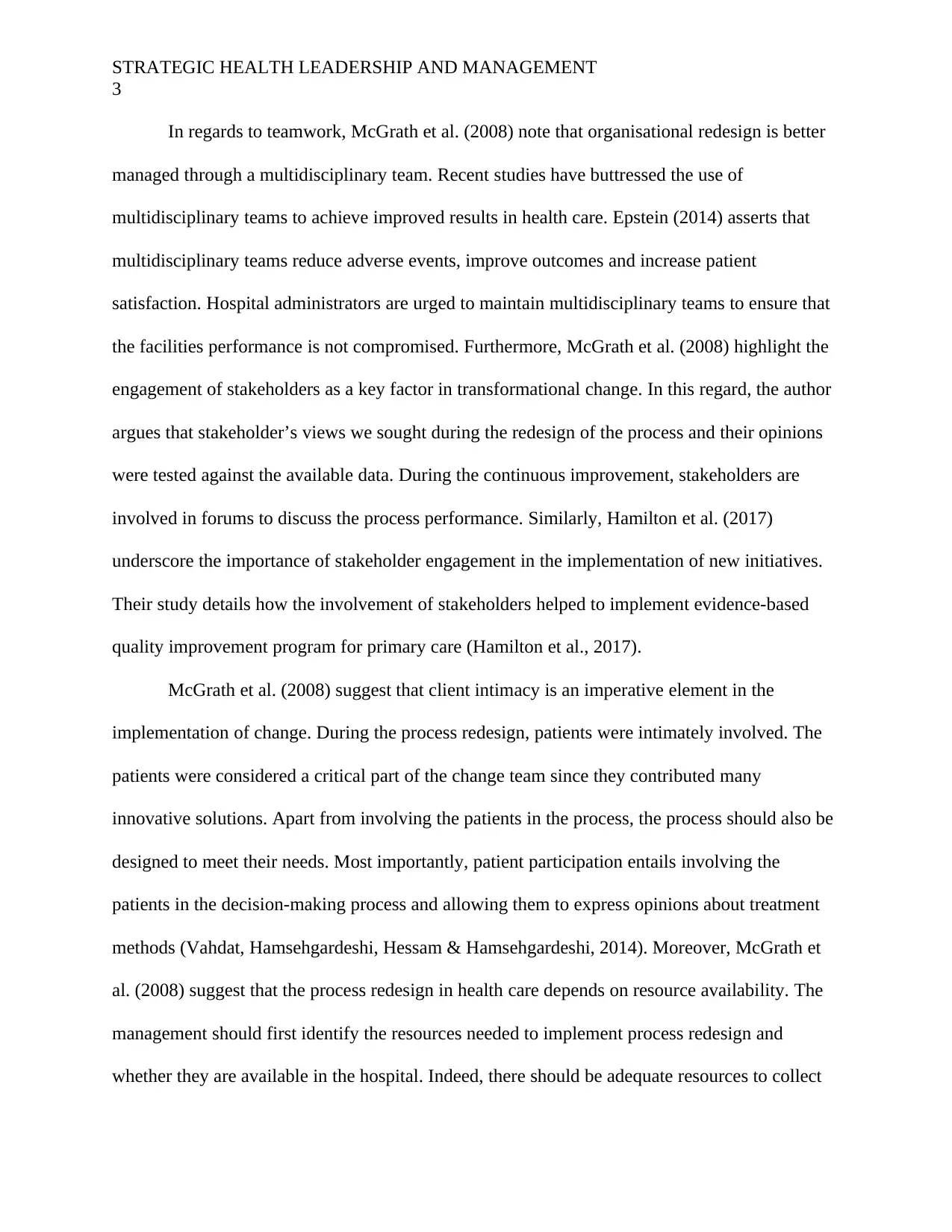
STRATEGIC HEALTH LEADERSHIP AND MANAGEMENT
3
In regards to teamwork, McGrath et al. (2008) note that organisational redesign is better
managed through a multidisciplinary team. Recent studies have buttressed the use of
multidisciplinary teams to achieve improved results in health care. Epstein (2014) asserts that
multidisciplinary teams reduce adverse events, improve outcomes and increase patient
satisfaction. Hospital administrators are urged to maintain multidisciplinary teams to ensure that
the facilities performance is not compromised. Furthermore, McGrath et al. (2008) highlight the
engagement of stakeholders as a key factor in transformational change. In this regard, the author
argues that stakeholder’s views we sought during the redesign of the process and their opinions
were tested against the available data. During the continuous improvement, stakeholders are
involved in forums to discuss the process performance. Similarly, Hamilton et al. (2017)
underscore the importance of stakeholder engagement in the implementation of new initiatives.
Their study details how the involvement of stakeholders helped to implement evidence-based
quality improvement program for primary care (Hamilton et al., 2017).
McGrath et al. (2008) suggest that client intimacy is an imperative element in the
implementation of change. During the process redesign, patients were intimately involved. The
patients were considered a critical part of the change team since they contributed many
innovative solutions. Apart from involving the patients in the process, the process should also be
designed to meet their needs. Most importantly, patient participation entails involving the
patients in the decision-making process and allowing them to express opinions about treatment
methods (Vahdat, Hamsehgardeshi, Hessam & Hamsehgardeshi, 2014). Moreover, McGrath et
al. (2008) suggest that the process redesign in health care depends on resource availability. The
management should first identify the resources needed to implement process redesign and
whether they are available in the hospital. Indeed, there should be adequate resources to collect
3
In regards to teamwork, McGrath et al. (2008) note that organisational redesign is better
managed through a multidisciplinary team. Recent studies have buttressed the use of
multidisciplinary teams to achieve improved results in health care. Epstein (2014) asserts that
multidisciplinary teams reduce adverse events, improve outcomes and increase patient
satisfaction. Hospital administrators are urged to maintain multidisciplinary teams to ensure that
the facilities performance is not compromised. Furthermore, McGrath et al. (2008) highlight the
engagement of stakeholders as a key factor in transformational change. In this regard, the author
argues that stakeholder’s views we sought during the redesign of the process and their opinions
were tested against the available data. During the continuous improvement, stakeholders are
involved in forums to discuss the process performance. Similarly, Hamilton et al. (2017)
underscore the importance of stakeholder engagement in the implementation of new initiatives.
Their study details how the involvement of stakeholders helped to implement evidence-based
quality improvement program for primary care (Hamilton et al., 2017).
McGrath et al. (2008) suggest that client intimacy is an imperative element in the
implementation of change. During the process redesign, patients were intimately involved. The
patients were considered a critical part of the change team since they contributed many
innovative solutions. Apart from involving the patients in the process, the process should also be
designed to meet their needs. Most importantly, patient participation entails involving the
patients in the decision-making process and allowing them to express opinions about treatment
methods (Vahdat, Hamsehgardeshi, Hessam & Hamsehgardeshi, 2014). Moreover, McGrath et
al. (2008) suggest that the process redesign in health care depends on resource availability. The
management should first identify the resources needed to implement process redesign and
whether they are available in the hospital. Indeed, there should be adequate resources to collect
⊘ This is a preview!⊘
Do you want full access?
Subscribe today to unlock all pages.

Trusted by 1+ million students worldwide
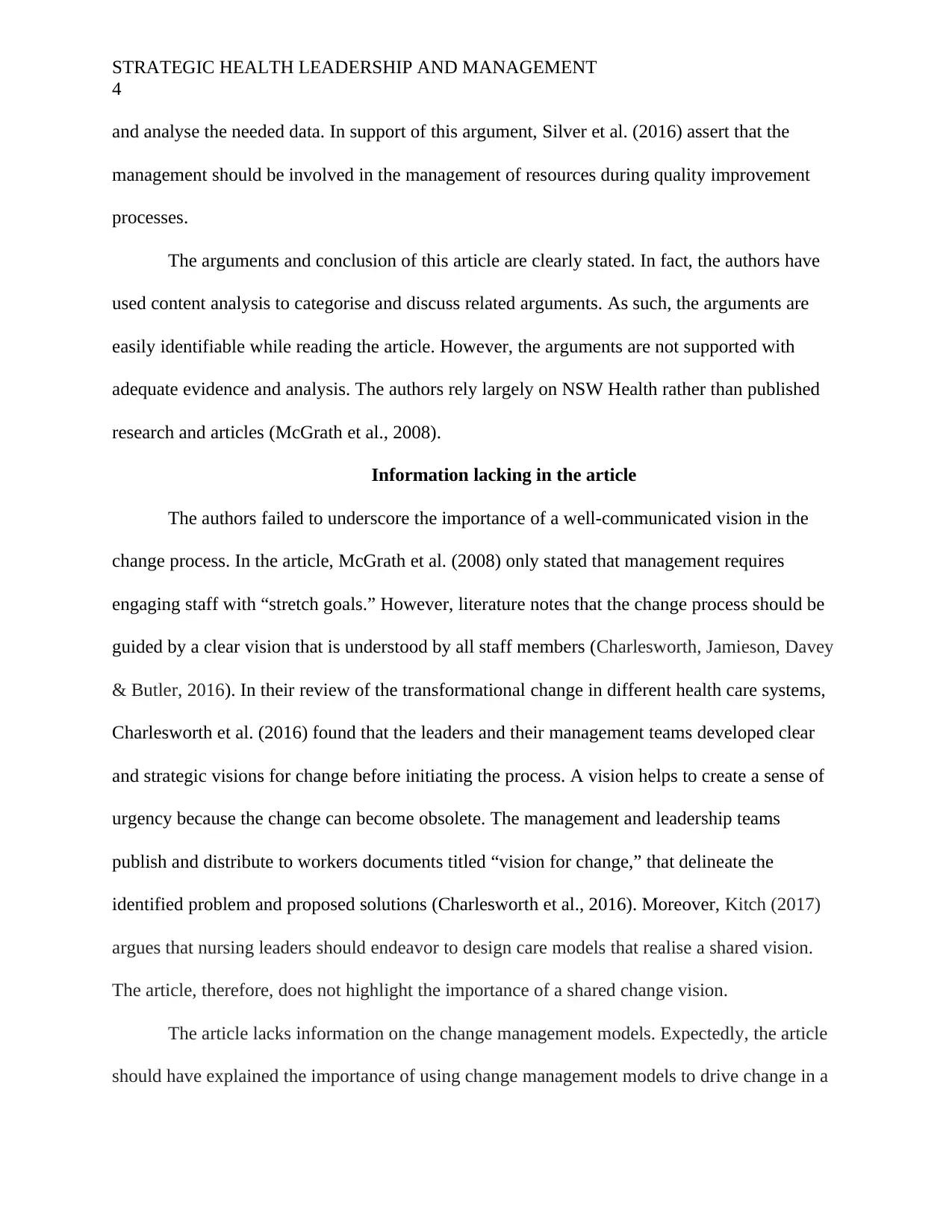
STRATEGIC HEALTH LEADERSHIP AND MANAGEMENT
4
and analyse the needed data. In support of this argument, Silver et al. (2016) assert that the
management should be involved in the management of resources during quality improvement
processes.
The arguments and conclusion of this article are clearly stated. In fact, the authors have
used content analysis to categorise and discuss related arguments. As such, the arguments are
easily identifiable while reading the article. However, the arguments are not supported with
adequate evidence and analysis. The authors rely largely on NSW Health rather than published
research and articles (McGrath et al., 2008).
Information lacking in the article
The authors failed to underscore the importance of a well-communicated vision in the
change process. In the article, McGrath et al. (2008) only stated that management requires
engaging staff with “stretch goals.” However, literature notes that the change process should be
guided by a clear vision that is understood by all staff members (Charlesworth, Jamieson, Davey
& Butler, 2016). In their review of the transformational change in different health care systems,
Charlesworth et al. (2016) found that the leaders and their management teams developed clear
and strategic visions for change before initiating the process. A vision helps to create a sense of
urgency because the change can become obsolete. The management and leadership teams
publish and distribute to workers documents titled “vision for change,” that delineate the
identified problem and proposed solutions (Charlesworth et al., 2016). Moreover, Kitch (2017)
argues that nursing leaders should endeavor to design care models that realise a shared vision.
The article, therefore, does not highlight the importance of a shared change vision.
The article lacks information on the change management models. Expectedly, the article
should have explained the importance of using change management models to drive change in a
4
and analyse the needed data. In support of this argument, Silver et al. (2016) assert that the
management should be involved in the management of resources during quality improvement
processes.
The arguments and conclusion of this article are clearly stated. In fact, the authors have
used content analysis to categorise and discuss related arguments. As such, the arguments are
easily identifiable while reading the article. However, the arguments are not supported with
adequate evidence and analysis. The authors rely largely on NSW Health rather than published
research and articles (McGrath et al., 2008).
Information lacking in the article
The authors failed to underscore the importance of a well-communicated vision in the
change process. In the article, McGrath et al. (2008) only stated that management requires
engaging staff with “stretch goals.” However, literature notes that the change process should be
guided by a clear vision that is understood by all staff members (Charlesworth, Jamieson, Davey
& Butler, 2016). In their review of the transformational change in different health care systems,
Charlesworth et al. (2016) found that the leaders and their management teams developed clear
and strategic visions for change before initiating the process. A vision helps to create a sense of
urgency because the change can become obsolete. The management and leadership teams
publish and distribute to workers documents titled “vision for change,” that delineate the
identified problem and proposed solutions (Charlesworth et al., 2016). Moreover, Kitch (2017)
argues that nursing leaders should endeavor to design care models that realise a shared vision.
The article, therefore, does not highlight the importance of a shared change vision.
The article lacks information on the change management models. Expectedly, the article
should have explained the importance of using change management models to drive change in a
Paraphrase This Document
Need a fresh take? Get an instant paraphrase of this document with our AI Paraphraser
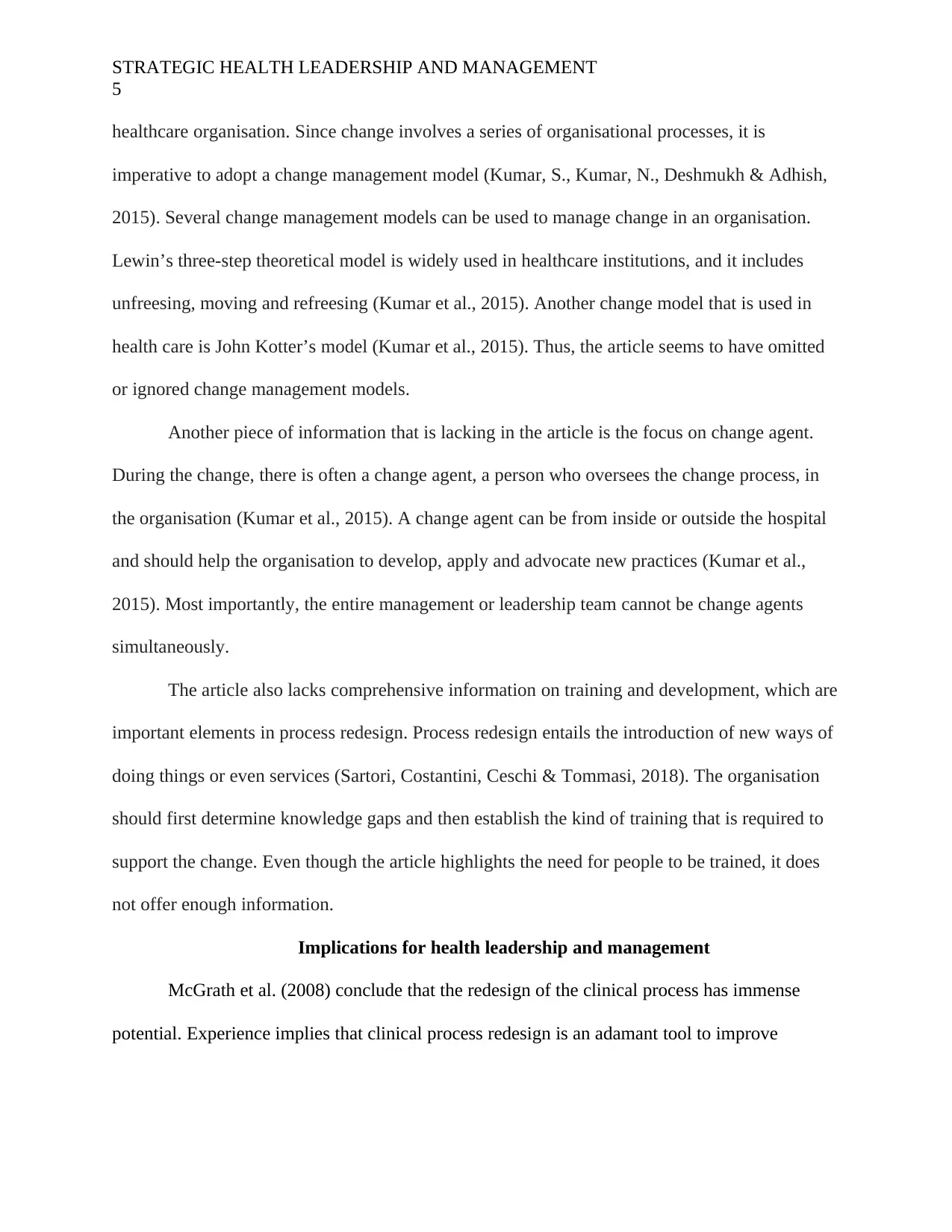
STRATEGIC HEALTH LEADERSHIP AND MANAGEMENT
5
healthcare organisation. Since change involves a series of organisational processes, it is
imperative to adopt a change management model (Kumar, S., Kumar, N., Deshmukh & Adhish,
2015). Several change management models can be used to manage change in an organisation.
Lewin’s three-step theoretical model is widely used in healthcare institutions, and it includes
unfreesing, moving and refreesing (Kumar et al., 2015). Another change model that is used in
health care is John Kotter’s model (Kumar et al., 2015). Thus, the article seems to have omitted
or ignored change management models.
Another piece of information that is lacking in the article is the focus on change agent.
During the change, there is often a change agent, a person who oversees the change process, in
the organisation (Kumar et al., 2015). A change agent can be from inside or outside the hospital
and should help the organisation to develop, apply and advocate new practices (Kumar et al.,
2015). Most importantly, the entire management or leadership team cannot be change agents
simultaneously.
The article also lacks comprehensive information on training and development, which are
important elements in process redesign. Process redesign entails the introduction of new ways of
doing things or even services (Sartori, Costantini, Ceschi & Tommasi, 2018). The organisation
should first determine knowledge gaps and then establish the kind of training that is required to
support the change. Even though the article highlights the need for people to be trained, it does
not offer enough information.
Implications for health leadership and management
McGrath et al. (2008) conclude that the redesign of the clinical process has immense
potential. Experience implies that clinical process redesign is an adamant tool to improve
5
healthcare organisation. Since change involves a series of organisational processes, it is
imperative to adopt a change management model (Kumar, S., Kumar, N., Deshmukh & Adhish,
2015). Several change management models can be used to manage change in an organisation.
Lewin’s three-step theoretical model is widely used in healthcare institutions, and it includes
unfreesing, moving and refreesing (Kumar et al., 2015). Another change model that is used in
health care is John Kotter’s model (Kumar et al., 2015). Thus, the article seems to have omitted
or ignored change management models.
Another piece of information that is lacking in the article is the focus on change agent.
During the change, there is often a change agent, a person who oversees the change process, in
the organisation (Kumar et al., 2015). A change agent can be from inside or outside the hospital
and should help the organisation to develop, apply and advocate new practices (Kumar et al.,
2015). Most importantly, the entire management or leadership team cannot be change agents
simultaneously.
The article also lacks comprehensive information on training and development, which are
important elements in process redesign. Process redesign entails the introduction of new ways of
doing things or even services (Sartori, Costantini, Ceschi & Tommasi, 2018). The organisation
should first determine knowledge gaps and then establish the kind of training that is required to
support the change. Even though the article highlights the need for people to be trained, it does
not offer enough information.
Implications for health leadership and management
McGrath et al. (2008) conclude that the redesign of the clinical process has immense
potential. Experience implies that clinical process redesign is an adamant tool to improve
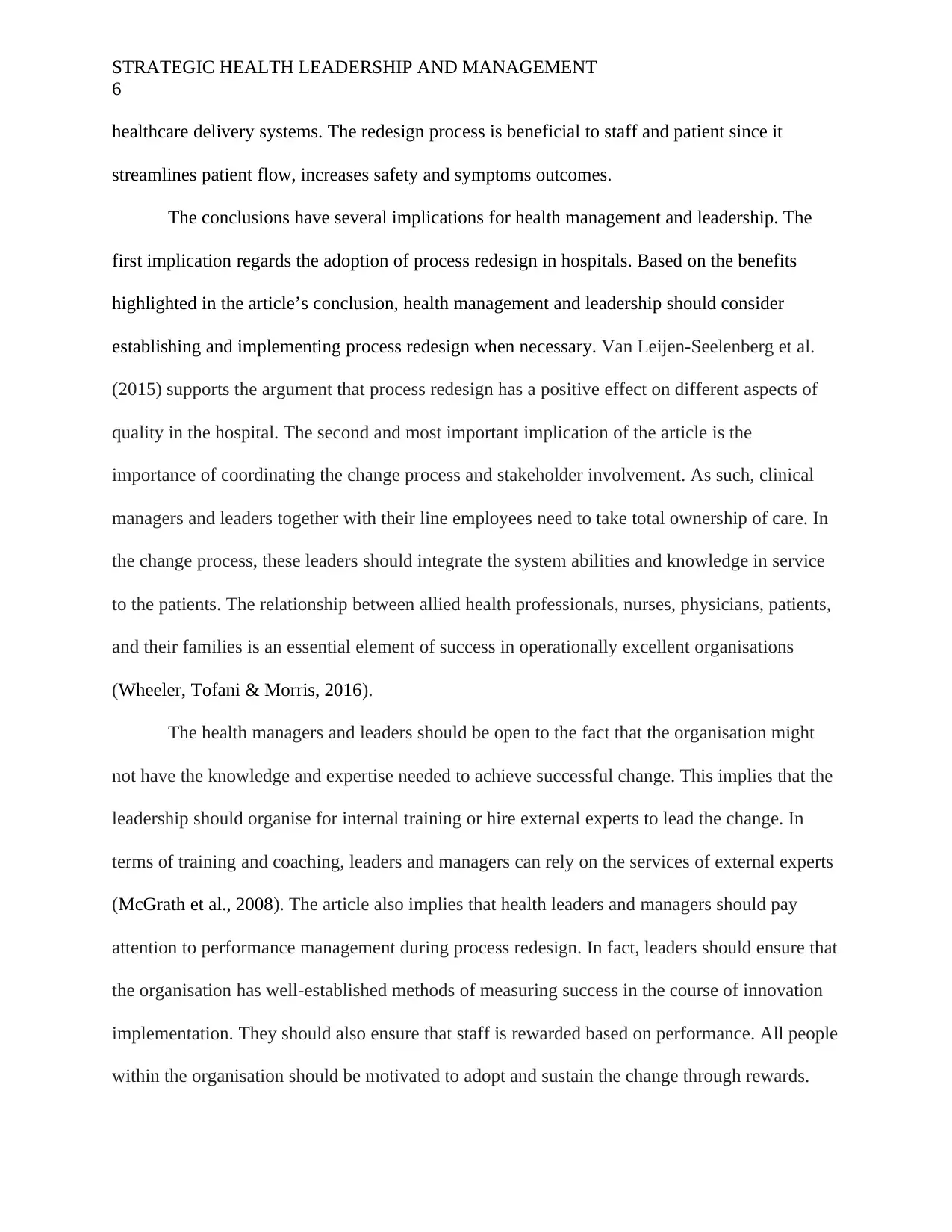
STRATEGIC HEALTH LEADERSHIP AND MANAGEMENT
6
healthcare delivery systems. The redesign process is beneficial to staff and patient since it
streamlines patient flow, increases safety and symptoms outcomes.
The conclusions have several implications for health management and leadership. The
first implication regards the adoption of process redesign in hospitals. Based on the benefits
highlighted in the article’s conclusion, health management and leadership should consider
establishing and implementing process redesign when necessary. Van Leijen-Seelenberg et al.
(2015) supports the argument that process redesign has a positive effect on different aspects of
quality in the hospital. The second and most important implication of the article is the
importance of coordinating the change process and stakeholder involvement. As such, clinical
managers and leaders together with their line employees need to take total ownership of care. In
the change process, these leaders should integrate the system abilities and knowledge in service
to the patients. The relationship between allied health professionals, nurses, physicians, patients,
and their families is an essential element of success in operationally excellent organisations
(Wheeler, Tofani & Morris, 2016).
The health managers and leaders should be open to the fact that the organisation might
not have the knowledge and expertise needed to achieve successful change. This implies that the
leadership should organise for internal training or hire external experts to lead the change. In
terms of training and coaching, leaders and managers can rely on the services of external experts
(McGrath et al., 2008). The article also implies that health leaders and managers should pay
attention to performance management during process redesign. In fact, leaders should ensure that
the organisation has well-established methods of measuring success in the course of innovation
implementation. They should also ensure that staff is rewarded based on performance. All people
within the organisation should be motivated to adopt and sustain the change through rewards.
6
healthcare delivery systems. The redesign process is beneficial to staff and patient since it
streamlines patient flow, increases safety and symptoms outcomes.
The conclusions have several implications for health management and leadership. The
first implication regards the adoption of process redesign in hospitals. Based on the benefits
highlighted in the article’s conclusion, health management and leadership should consider
establishing and implementing process redesign when necessary. Van Leijen-Seelenberg et al.
(2015) supports the argument that process redesign has a positive effect on different aspects of
quality in the hospital. The second and most important implication of the article is the
importance of coordinating the change process and stakeholder involvement. As such, clinical
managers and leaders together with their line employees need to take total ownership of care. In
the change process, these leaders should integrate the system abilities and knowledge in service
to the patients. The relationship between allied health professionals, nurses, physicians, patients,
and their families is an essential element of success in operationally excellent organisations
(Wheeler, Tofani & Morris, 2016).
The health managers and leaders should be open to the fact that the organisation might
not have the knowledge and expertise needed to achieve successful change. This implies that the
leadership should organise for internal training or hire external experts to lead the change. In
terms of training and coaching, leaders and managers can rely on the services of external experts
(McGrath et al., 2008). The article also implies that health leaders and managers should pay
attention to performance management during process redesign. In fact, leaders should ensure that
the organisation has well-established methods of measuring success in the course of innovation
implementation. They should also ensure that staff is rewarded based on performance. All people
within the organisation should be motivated to adopt and sustain the change through rewards.
⊘ This is a preview!⊘
Do you want full access?
Subscribe today to unlock all pages.

Trusted by 1+ million students worldwide
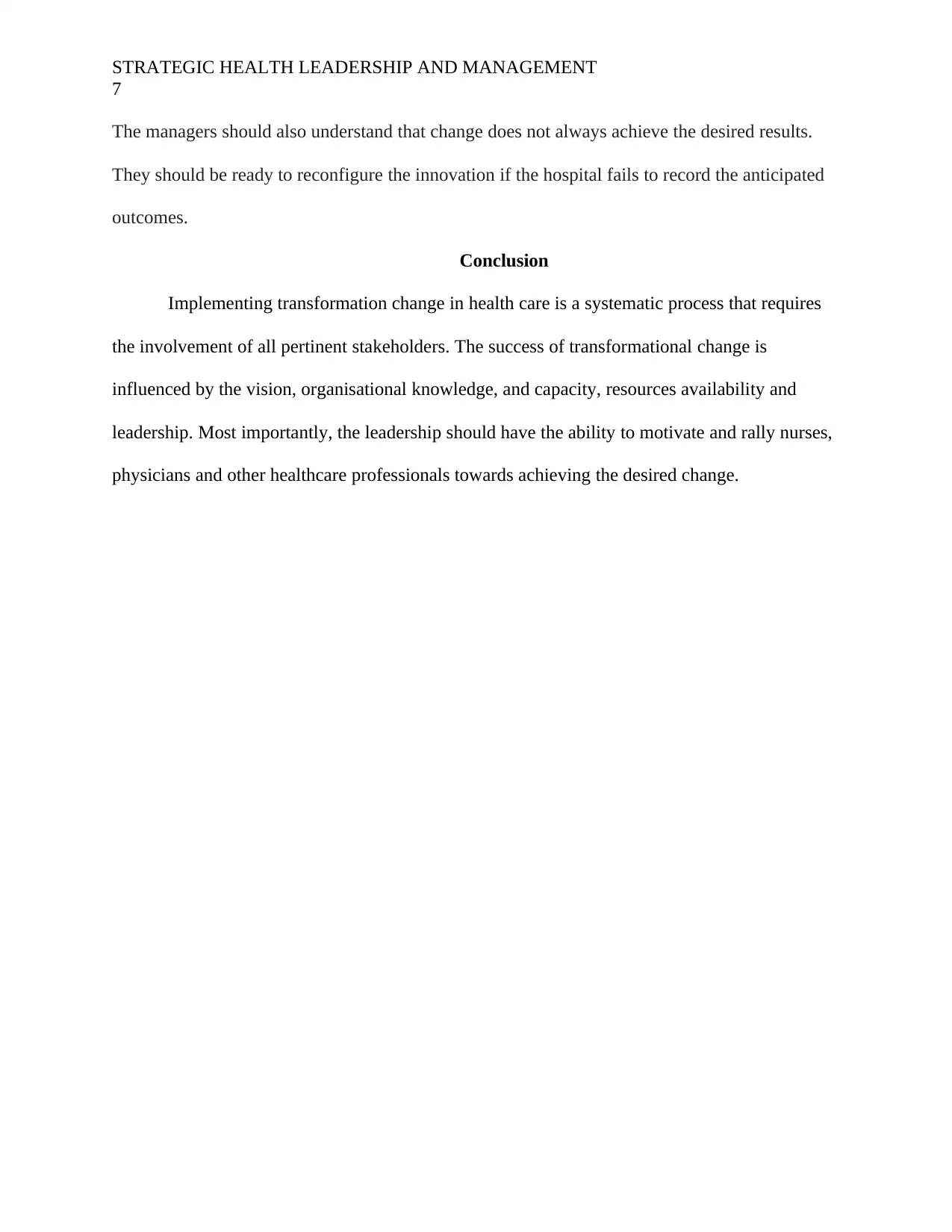
STRATEGIC HEALTH LEADERSHIP AND MANAGEMENT
7
The managers should also understand that change does not always achieve the desired results.
They should be ready to reconfigure the innovation if the hospital fails to record the anticipated
outcomes.
Conclusion
Implementing transformation change in health care is a systematic process that requires
the involvement of all pertinent stakeholders. The success of transformational change is
influenced by the vision, organisational knowledge, and capacity, resources availability and
leadership. Most importantly, the leadership should have the ability to motivate and rally nurses,
physicians and other healthcare professionals towards achieving the desired change.
7
The managers should also understand that change does not always achieve the desired results.
They should be ready to reconfigure the innovation if the hospital fails to record the anticipated
outcomes.
Conclusion
Implementing transformation change in health care is a systematic process that requires
the involvement of all pertinent stakeholders. The success of transformational change is
influenced by the vision, organisational knowledge, and capacity, resources availability and
leadership. Most importantly, the leadership should have the ability to motivate and rally nurses,
physicians and other healthcare professionals towards achieving the desired change.
Paraphrase This Document
Need a fresh take? Get an instant paraphrase of this document with our AI Paraphraser
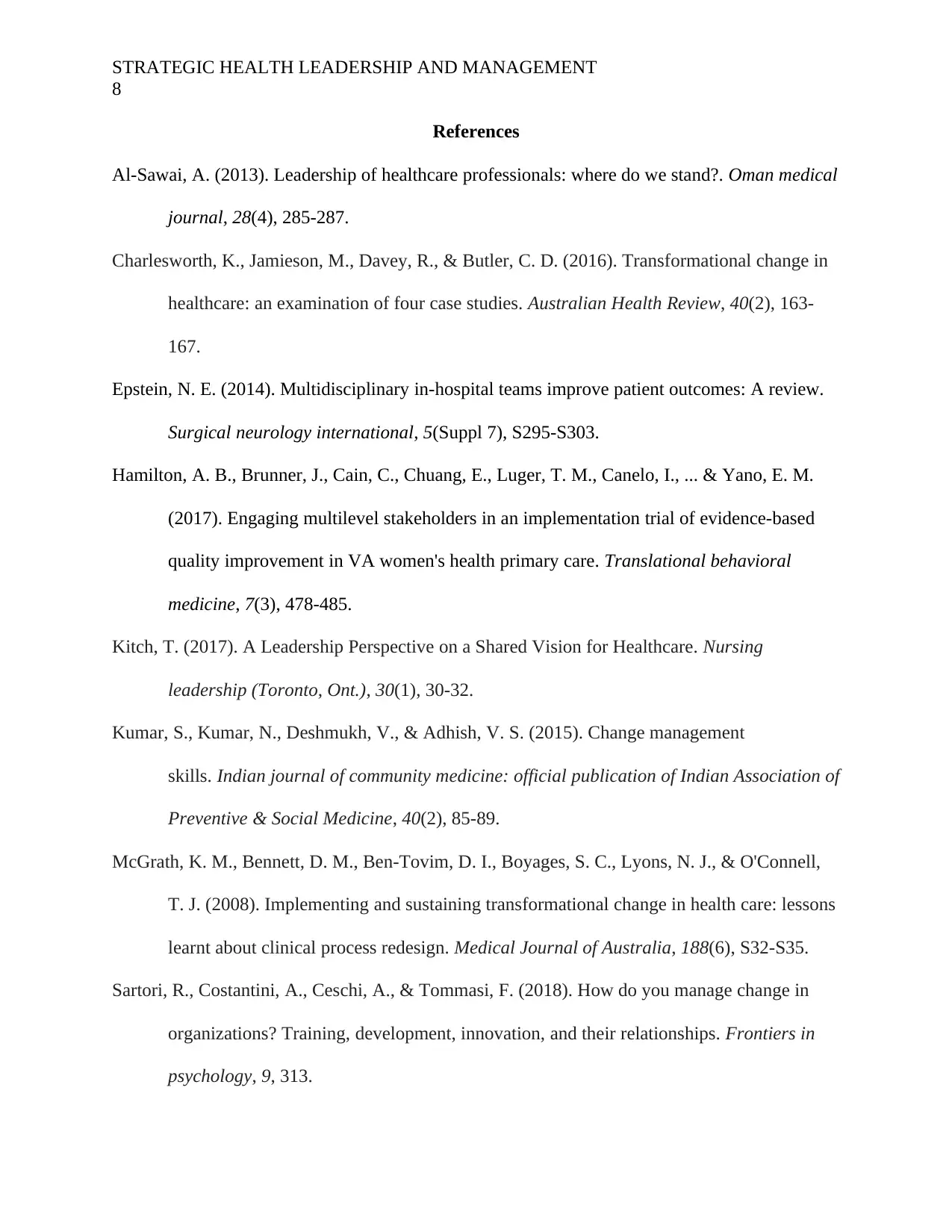
STRATEGIC HEALTH LEADERSHIP AND MANAGEMENT
8
References
Al-Sawai, A. (2013). Leadership of healthcare professionals: where do we stand?. Oman medical
journal, 28(4), 285-287.
Charlesworth, K., Jamieson, M., Davey, R., & Butler, C. D. (2016). Transformational change in
healthcare: an examination of four case studies. Australian Health Review, 40(2), 163-
167.
Epstein, N. E. (2014). Multidisciplinary in-hospital teams improve patient outcomes: A review.
Surgical neurology international, 5(Suppl 7), S295-S303.
Hamilton, A. B., Brunner, J., Cain, C., Chuang, E., Luger, T. M., Canelo, I., ... & Yano, E. M.
(2017). Engaging multilevel stakeholders in an implementation trial of evidence-based
quality improvement in VA women's health primary care. Translational behavioral
medicine, 7(3), 478-485.
Kitch, T. (2017). A Leadership Perspective on a Shared Vision for Healthcare. Nursing
leadership (Toronto, Ont.), 30(1), 30-32.
Kumar, S., Kumar, N., Deshmukh, V., & Adhish, V. S. (2015). Change management
skills. Indian journal of community medicine: official publication of Indian Association of
Preventive & Social Medicine, 40(2), 85-89.
McGrath, K. M., Bennett, D. M., Ben-Tovim, D. I., Boyages, S. C., Lyons, N. J., & O'Connell,
T. J. (2008). Implementing and sustaining transformational change in health care: lessons
learnt about clinical process redesign. Medical Journal of Australia, 188(6), S32-S35.
Sartori, R., Costantini, A., Ceschi, A., & Tommasi, F. (2018). How do you manage change in
organizations? Training, development, innovation, and their relationships. Frontiers in
psychology, 9, 313.
8
References
Al-Sawai, A. (2013). Leadership of healthcare professionals: where do we stand?. Oman medical
journal, 28(4), 285-287.
Charlesworth, K., Jamieson, M., Davey, R., & Butler, C. D. (2016). Transformational change in
healthcare: an examination of four case studies. Australian Health Review, 40(2), 163-
167.
Epstein, N. E. (2014). Multidisciplinary in-hospital teams improve patient outcomes: A review.
Surgical neurology international, 5(Suppl 7), S295-S303.
Hamilton, A. B., Brunner, J., Cain, C., Chuang, E., Luger, T. M., Canelo, I., ... & Yano, E. M.
(2017). Engaging multilevel stakeholders in an implementation trial of evidence-based
quality improvement in VA women's health primary care. Translational behavioral
medicine, 7(3), 478-485.
Kitch, T. (2017). A Leadership Perspective on a Shared Vision for Healthcare. Nursing
leadership (Toronto, Ont.), 30(1), 30-32.
Kumar, S., Kumar, N., Deshmukh, V., & Adhish, V. S. (2015). Change management
skills. Indian journal of community medicine: official publication of Indian Association of
Preventive & Social Medicine, 40(2), 85-89.
McGrath, K. M., Bennett, D. M., Ben-Tovim, D. I., Boyages, S. C., Lyons, N. J., & O'Connell,
T. J. (2008). Implementing and sustaining transformational change in health care: lessons
learnt about clinical process redesign. Medical Journal of Australia, 188(6), S32-S35.
Sartori, R., Costantini, A., Ceschi, A., & Tommasi, F. (2018). How do you manage change in
organizations? Training, development, innovation, and their relationships. Frontiers in
psychology, 9, 313.
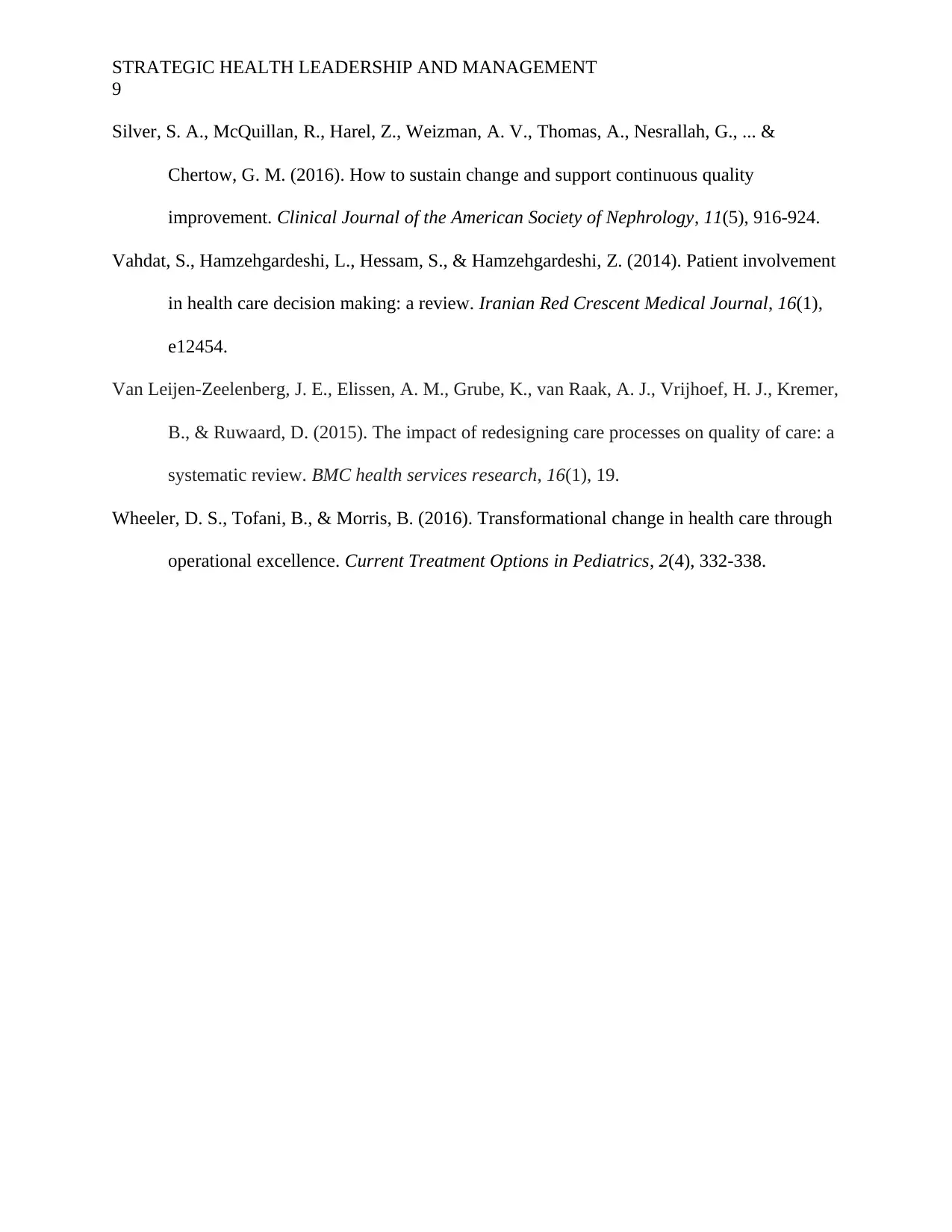
STRATEGIC HEALTH LEADERSHIP AND MANAGEMENT
9
Silver, S. A., McQuillan, R., Harel, Z., Weizman, A. V., Thomas, A., Nesrallah, G., ... &
Chertow, G. M. (2016). How to sustain change and support continuous quality
improvement. Clinical Journal of the American Society of Nephrology, 11(5), 916-924.
Vahdat, S., Hamzehgardeshi, L., Hessam, S., & Hamzehgardeshi, Z. (2014). Patient involvement
in health care decision making: a review. Iranian Red Crescent Medical Journal, 16(1),
e12454.
Van Leijen-Zeelenberg, J. E., Elissen, A. M., Grube, K., van Raak, A. J., Vrijhoef, H. J., Kremer,
B., & Ruwaard, D. (2015). The impact of redesigning care processes on quality of care: a
systematic review. BMC health services research, 16(1), 19.
Wheeler, D. S., Tofani, B., & Morris, B. (2016). Transformational change in health care through
operational excellence. Current Treatment Options in Pediatrics, 2(4), 332-338.
9
Silver, S. A., McQuillan, R., Harel, Z., Weizman, A. V., Thomas, A., Nesrallah, G., ... &
Chertow, G. M. (2016). How to sustain change and support continuous quality
improvement. Clinical Journal of the American Society of Nephrology, 11(5), 916-924.
Vahdat, S., Hamzehgardeshi, L., Hessam, S., & Hamzehgardeshi, Z. (2014). Patient involvement
in health care decision making: a review. Iranian Red Crescent Medical Journal, 16(1),
e12454.
Van Leijen-Zeelenberg, J. E., Elissen, A. M., Grube, K., van Raak, A. J., Vrijhoef, H. J., Kremer,
B., & Ruwaard, D. (2015). The impact of redesigning care processes on quality of care: a
systematic review. BMC health services research, 16(1), 19.
Wheeler, D. S., Tofani, B., & Morris, B. (2016). Transformational change in health care through
operational excellence. Current Treatment Options in Pediatrics, 2(4), 332-338.
⊘ This is a preview!⊘
Do you want full access?
Subscribe today to unlock all pages.

Trusted by 1+ million students worldwide
1 out of 9
Related Documents
Your All-in-One AI-Powered Toolkit for Academic Success.
+13062052269
info@desklib.com
Available 24*7 on WhatsApp / Email
![[object Object]](/_next/static/media/star-bottom.7253800d.svg)
Unlock your academic potential
Copyright © 2020–2025 A2Z Services. All Rights Reserved. Developed and managed by ZUCOL.





